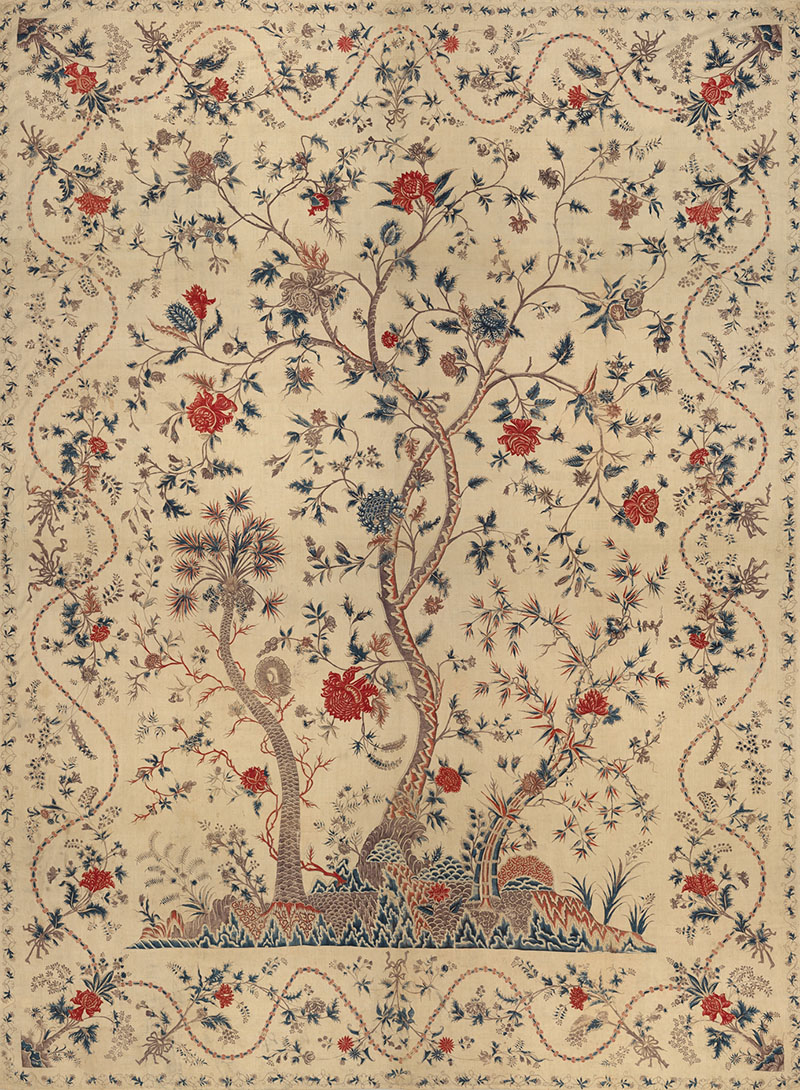A popular motif used in textile design, handicrafts and fine arts depicting a tree with emanating branches, is called Tree of Life. It draws from the symbolism of the primordial tree as is present in cultures of Asia, Africa, Europe and Oceania. The symbol depicts an upright tree with distinctive branches shooting off from it, sometimes bare and sometimes laden with leaves, fruits and flowers. In India, theTree of Life comes from several sources such as the Bodhi tree under which Buddha received enlightenment; the Peepal and Banyan trees associated with Hindu mythology; and as the tree of immortality alluded to in Islam. The Tree of Life symbol was used as a decorative biomorphic motif as early as the mid-sixteenth century. For instance, in the Sidi Saiyyed Mosque in Ahmedabad, a carved stone window dating to 1573 showcases a set of finely drawn trees. The symbol also features on a mirror frame designed in the Mughal court in the 17th–18th century, where the mirror’s jade frame is inlaid with gold stems and leaves, buds of rubies, diamonds and emerald.
The Tree of Life was featured on chintz, silks and printed cloth and has been depicted using techniques ranging from resist-dyeing methods like batik, block printing, mordant painting, handweaving and embroidery. The Portuguese, the Dutch and then the British East India Companies not only traded the fabric but also used it in South-east Asia as currency to exchange for spices. Hence, the symbol travelled through the world and took on many variations. For instance, the motif of tumpal – an isosceles triangle arranged one after the other on a fabric’s border – wasn’t found among the motifs in use in the Indian mainland and is conjectured to have been incorporated to suit the tastes of the Indonesian market, where the design has a long history of appreciation. Another example is the conception of phaa nung, a palmette design covered with gold gilt that was made for the Thai court and fused the style of kalamkari, the architectural niche of mihrab and the design of Tree of Life along with that of floral bouquet. In Europe, through the influence of the British East India Company, the symbol was depicted on large cotton bed coverings known as pampalores, tent panels and later as wall hangings and table linens. Complementing the European interest in chinoiserie, China produced wallpapers and silk wallcoverings modeled after Indian pampalores.
Today, Tree of Life is a one of the commonly used motifs in handwoven fabrics like Banarasi, Chanderi and Jamdani and is also used to decorate the border of a saree apart from featuring on a wide variety of other garments. The motif is no longer limited to large scale depictions or as currency for trading but continues to be popular in the textile industry within India.






![The façade of the Maneckji Seth Agiary, a Zoroastrian fire temple, is a standout example of the popularity of the Persian Revival Style in Western India in the 19th and 20th centuries. This style was often seen in the architectural patronage of the Parsis, who emerged as one of the most influential mercantile communities of British India. Popular motifs of this style, like the mythical lamasus (winged bulls with human heads) and the faravahar (a winged guardian spirit in Zoroastrianism), drew on the historical art and architecture of the Achaemenid and Sasanian empires from sites like Persepolis, Bisotun, Taq-e Bostan, Naqsh-e Rostam and Naqsh-e Rajab in Persia.
The Parsi community’s adoption of this style occurred largely due to their networks of global commerce and politics, allowing them to access and translate research of ancient Persia into visible symbols that underlined their association with antiquity, imperial power, and art.
نمای آتشکدهی زرتشتی مانِکجی سِت نمونهی بارزی از رواج سبک «احیای [معماری] ایرانی» در غرب هند طی سدههای نوزدهم و بیستم است. این سبک غالباً در بناهایی دیده میشد که پارسیان، از بانفوذترین جوامع بازرگان در هند بریتانیا، بانیشان بودند. نقشمایههای محبوب این سبک، مانند گاو بالدار اساطیری (لاماسو) و فَروَهَر (روح بالدار نگهبان در دین زرتشت)، برگرفته از هنر و معماری شاهنشاهی هخامنشی و ساسانی، در جاهایی چون تخت جمشید و بیستون و طاق بستان و نقش رستم و نقش رجب، بود.
اقتباس جامعهی پارسیان از این سبک بسیار مرهون روابط گستردهی تجاری و سیاسی آنها بود که دسترس به پژوهشها دربارهی ایران باستان و برگردانیدن آنها به نمادهای بصری را ممکن میکرد و بر پیوند پارسیان با دوران باستان و قدرت شاهنشاهی و هنر تأکید میکرد.](https://mapacademy.io/wp-content/plugins/instagram-feed/img/placeholder.png)
